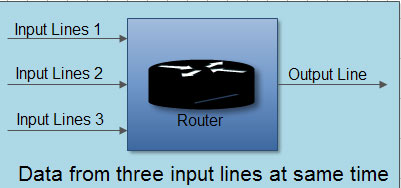CONGESTION CONTROL
Congestion is an important issue that can arise in packet switched network. Congestion is a situation in Communication Networks in which too many packets are present in a part of the subnet, performance degrades. Congestion control is a global issue – involves every router and host within the subnet. Flow control – scope is point-to-point; involves just sender and receiver. Congestion in a network may occur when the load on the network(i.e. the number of packets sent to the network) is greater than the capacity of the network (i.e. the number of packets a network can handle.)
CAUSES OF CONGESTION CONTROL
Congestion is an important issue that can arise in packet switched network. Congestion is a situation in Communication Networks in which too many packets are present in a part of the subnet, performance degrades. Congestion control is a global issue – involves every router and host within the subnet. Flow control – scope is point-to-point; involves just sender and receiver. Congestion in a network may occur when the load on the network(i.e. the number of packets sent to the network) is greater than the capacity of the network (i.e. the number of packets a network can handle.)
CAUSES OF CONGESTION CONTROL
The various causes of congestion in a subnet are:
- 1.The input traffic rate exceeds the capacity of the output lines. If suddenly, a stream of packet start arriving on three or four input lines and all need the same output line. In this case, a queue will be built up. If there is insufficient memory to hold all the packets, the packet will be lost. Increasing the memory to unlimited size does not solve the problem. This is because, by the time packets reach front of the queue, they have already timed out (as they waited the queue). When timer goes off source transmits duplicate packet that are also added to the queue. Thus same packets are added again and again, increasing the load all the way to the destination.

- 1.The input traffic rate exceeds the capacity of the output lines. If suddenly, a stream of packet start arriving on three or four input lines and all need the same output line. In this case, a queue will be built up. If there is insufficient memory to hold all the packets, the packet will be lost. Increasing the memory to unlimited size does not solve the problem. This is because, by the time packets reach front of the queue, they have already timed out (as they waited the queue). When timer goes off source transmits duplicate packet that are also added to the queue. Thus same packets are added again and again, increasing the load all the way to the destination.
2.The routers are too slow to perform bookkeeping tasks (queuing buffers, updating tables, etc.).
3.The routers' buffer is too limited.
4.Congestion in a subnet can occur if the processors are slow. Slow speed CPU at routers will perform the routine tasks such as queuing buffers, updating table etc slowly. As a result of this, queues are built up even though there is excess line capacity.
5.Congestion is also caused by slow links. This problem will be solved when high speed links are used. But it is not always the case. Sometimes increase in link bandwidth can further deteriorate the congestion problem as higher speed links may make the network more unbalanced.Congestion can make itself worse. If a route!" does not have free buffers, it start ignoring/discarding the newly arriving packets. When these packets are discarded, the sender may retransmit them after the timer goes off. Such packets are transmitted by the sender again and again until the source gets the acknowledgement of these packets. Therefore multiple transmissions of packets will force the congestion to take place at the sending end.
THE FOLLOWING TECHNIQUES ARE USED TO MANAGE THE CONGESTION CONTROL
- End-system flow control This is not a congestion control scheme, but a way to prevent the sender from overrunning the buffers of the receiver. See "Flow-Control Mechanisms."
- Network congestion control In this scheme, end systems throttle back in order to avoid congesting the network. The mechanism is similar to end-to-end flow controls, but the intention is to reduce congestion in the network, not the receiver.
- Network-based congestion avoidance In this scheme, a router detects that congestion may occur and attempts to slow down senders before queues become full.
- Resource allocation This technique involves scheduling the use of physical circuits or other resources, perhaps for a specific time period. A virtual circuit, built across a series a switches with a guaranteed bandwidth is a form of resource allocation. This technique is difficult, but can eliminate network congestion by blocking traffic that is in excess of the network capacity.



No comments:
Post a Comment